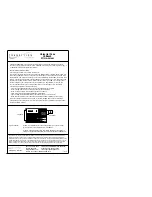
8.8
Corrective maintenance of measuring system
8.8.1
pH/mV electrodes
Soiling detected on glass electrodes can
be removed as follows:
•
Oily and greasy coatings
Clean with detergent (fat solvent, e.g.
alcohol, acetone, poss. detergent).
Warning:
Hands, eyes and clothes are to be
protected when using the cleaning
agents described below.
•
Limestone deposits or metal hydroxide
coatings
Loosen coatings with diluted hydrochloric
acid (3 %), then rinse thoroughly.
•
Coatings containing sulphide (from flue
gas desulphurising plants or sewage
treatment plants)
Use mixture of hydrochloric acid (0.5 %)
and thiourea (8 %), then rinse thoroughly.
•
Coatings containing protein (food industry)
Use mixture of hydrochloric acid (0.5 %)
and pepsin (1 %), then rinse thoroughly.
Mechanical cleaning of blocked
diaphragms may be possible
(does not
apply to Teflon diaphragm and ring gap
electrodes):
• Use a small key file
• File in one direction only
Air bubbles in the electrode
• Air bubbles may indicate an assembly
problem; check installation position
• The range from 15° to 165° from the
horizontal is permissible
• Horizontal installation or installation with the
plug-in head pointing down is not allowed
Redox electrodes
Careful mechanical cleaning of coated metal
pins or surfaces is possible.
8.8.2
Assembly
Please refer to the operating instructions for
the assembly in question for maintenance and
troubleshooting instructions. The operating
instructions also include instructions for
assembly and dismantling, sensor and gasket
replacement as well as information on
resistance, spare parts and accessories.
8.8.3
Liquid KCl supply
• KCl must flow without bubbles. Unpres-
surised version: cotton thread present?
• Counterpressure systems: pressure in KCl
reservoir must exceed medium pressure
by at least 0.8 bar.
• KCl consumption should be low but
noticeable. Approx. 1 ... 10 ml per day is
typical.
• Refill opening of sensors with KCl refill
opening on glass shaft must be open.
8.8.4
Connecting lines and junction boxes
Moisture is the most formidable enemy of
pH connections.
Moisture reduces the
sensor slope. It may prevent calibration
completely or may result in a fixed output
value of pH 7.
Check the following for moisture:
• Sensor head
• Sensor plug
• pH measuring cable
• Junction box if present
• pH measuring cable extension
The sensor head and junction box can be
cleaned and dried with a hair-drier.
Moisture in measuring cable: cable
replacement is mandatory!
A shunt in the cable of > 20 M
Ω
cannot be
measured with normal multimeters but is very
detrimental to pH measurement. Reliable
testing is possible with a commercially
available insulation resistance meter:
• Disconnect the pH measuring cable from
the sensor and instrument!
• If a junction box is used, the incoming and
outgoing pH cables should be checked
separately.
• Preferably test the cable with a test voltage
of 1000 V DC (but least with 500 V DC).
• Insulation resistance of an intact cable is
>100 G
Ω
.
• Defective (moist) cables will cause
flashover; cable replacement is mandatory!
> 15°
> 15°
PM253E08.CHP
Liquisys M CPM 223 / 253
Diagnosis and corrective maintenance
Hauser
65













































